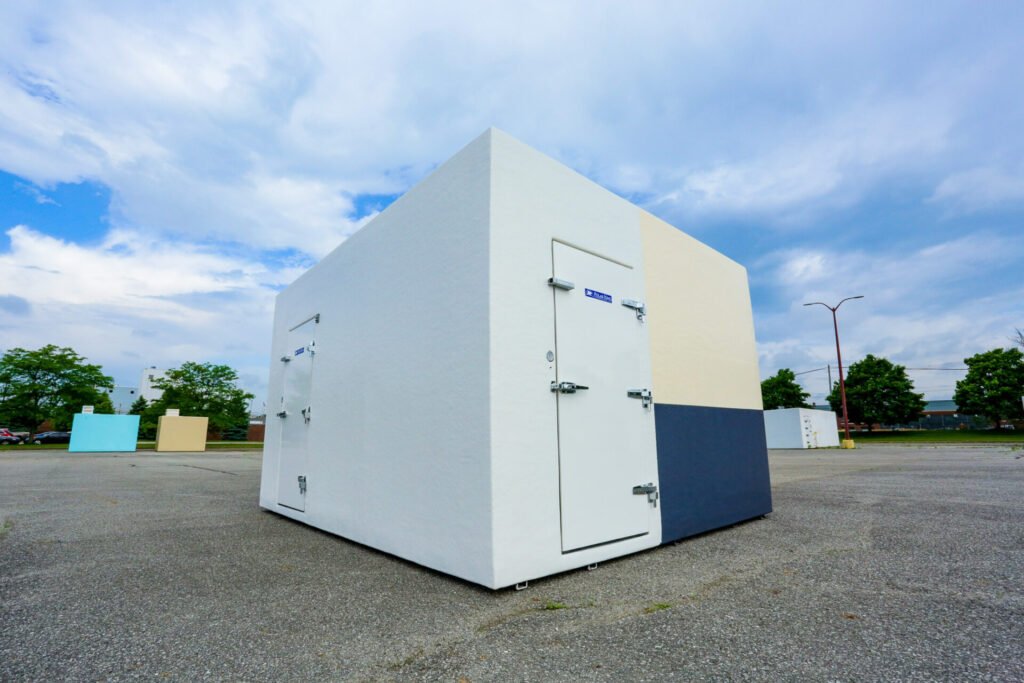Walk-in coolers are essential in preserving perishable goods across various industries. From keeping food fresh in restaurants to storing products in grocery stores, these refrigeration systems are an indispensable part of the modern food service operations.
Knowing the inner workings and maintenance needs of these units can help you keep them running efficiently, saving time and money. Let’s delve into the essentials of walk-in coolers and discover what’s beneath the surface.
The basics of walk-in coolers
Walk-in coolers are large, insulated rooms designed to maintain low temperatures for the storage of perishable goods. They are essential for preserving food quality and safety in commercial refrigeration settings.
Primary components:
Walk-in cooler compressor
Often referred to as the heart of the refrigeration system, the compressor pressurizes and circulates the refrigerant throughout the system. It plays a critical role in maintaining consistent cooling by enabling the refrigerant to absorb and release heat efficiently.
Condenser
The condenser is responsible for expelling heat from the refrigerant as it cycles through the system. Located either outside or on top of the cooler, it cools the high-pressure gas into a liquid by releasing heat into the surrounding air.
Evaporator
Positioned inside the cooler, the evaporator absorbs heat from the interior space as the refrigerant evaporates. This heat exchange process is what actually cools the air inside the unit, helping to maintain safe storage temperatures.
Walk-in cooler thermostat
The thermostat monitors and regulates the cooler’s internal temperature. It triggers the refrigeration cycle as needed, ensuring that the cooler stays within the desired temperature range for food safety and energy efficiency.
Insulation
High-quality insulation is essential for temperature stability and energy conservation. It minimizes heat gain from the external environment, reduces the strain on the cooling system, and helps maintain a uniform temperature throughout the cooler.
Walk-in cooler door
The door is designed with heavy-duty hinges, magnetic gaskets, and automatic closers to prevent warm air from entering. A properly sealed and insulated door is vital for maintaining internal temperatures and reducing energy loss.
Walk-in cooler shelves
Shelving systems are engineered for optimal airflow and efficient storage. Durable, corrosion-resistant materials support heavy loads while allowing cold air to circulate freely, ensuring even cooling across all stored items.
Temperature controls
Modern walk-in coolers often feature advanced digital temperature control systems. These allow for precise adjustments, real-time monitoring, and often include alarms or connectivity options for remote management and safety alerts.

How does a walk-in cooler work?
Refrigeration cycle explained
The refrigeration cycle is the process by which heat is removed from the cooler. The walk-in cooler compressor pumps refrigerant into the condenser, where it releases heat and becomes a high-pressure liquid. This liquid refrigerant then travels to the evaporator, which is located inside the cooler.
In the evaporator, the refrigerant absorbs heat from the walk-in cooler’s interior, causing it to evaporate and turn back into a low-pressure gas. This absorption of heat cools the interior of the walk-in.
The refrigerant, now a gas, returns to the compressor, where the cycle begins anew. This continuous cycle of heat absorption and dissipation ensures that the cooler maintains a consistently low temperature, crucial for preserving perishable items.
The refrigeration cycle can be broken down into four main stages:
- Compression: The walk-in cooler compressor compresses the refrigerant gas, raising its pressure and temperature.
- Condensation: The high-pressure gas flows into the condenser coils, where it releases heat to the surroundings and condenses into a high-pressure liquid.
- Expansion: The high-pressure liquid refrigerant then passes through an expansion valve, where it experiences a drop in pressure and temperature.
- Evaporation: The low-pressure liquid enters the evaporator coils inside the cooler, where it absorbs heat from the cooler’s interior and evaporates back into a gas. This process cools the air inside the walk-in cooler.
Each component in this cycle helps maintain the desired temperature. The walk-in cooler thermostat helps regulate this cycle by monitoring the internal temperature and signaling the compressor to start or stop as needed.
Maintenance tips for optimal performance
Regular cleaning: Learn how to clean the coils and interior of a walk-in cooler regularly to prevent mold and ensure efficient operation. Walk-in cooler maintenance is essential for longevity.
- Cleaning the coils: Clean the condenser and evaporator coils to maintain efficient heat exchange. Use a soft brush or vacuum to remove dust and debris.
Checking for leaks and seal integrity: Inspect door seals and repair any leaks to maintain energy efficiency and consistent cooling. Ensure the walk-in cooler door seals are intact.
Temperature monitoring: Regularly check the walk-in cooler thermostat settings to ensure the cooler operates at optimal temperatures.
Defrosting: Learn how to defrost a walk-in cooler periodically to prevent ice buildup, which can hinder performance.
Charging the system: If cooling efficiency drops, it might be necessary to charge the refrigeration system. Consult a professional for how to charge a walk-in cooler.

Troubleshooting common issues
Inefficient cooling – Check for blocked air vents, dirty coils, or low refrigerant levels. Ensure the door seals are intact. Address why your walk-in cooler is not cold effectively.
Frost build-up – Ensure proper defrost cycles and check for any issues with the door seals or thermostat. Understand why your walk-in cooler is freezing up and how to address it.
Strange noises – Identify unusual sounds from the walk-in cooler compressor or other components. These could indicate mechanical issues requiring professional attention.
Click here for more detail on troubleshooting common walk-in cooler issues.
Innovations in walk-in cooler technology
Energy efficiency improvements – Advancements in insulation, walk-in cooler compressor technology, and smart controls have significantly reduced energy consumption in modern, energy-efficient walk-in coolers.
Smart controls and monitoring – Modern systems offer real-time temperature monitoring and remote management, enhancing cooling technology efficiency and convenience.
FAQs
What size walk-in cooler do I need for my business?
The ideal size of a walk-in cooler depends on your specific storage needs, inventory turnover, and available space. Small restaurants may require a unit as small as 6’x6’, while larger operations like grocery stores or schools may need much bigger systems. Other considerations include the type of products being stored, how often stock is rotated, and the need for future expansion. For best results, consult a commercial refrigeration specialist who can assess your operation and recommend the optimal configuration.
How can I improve the energy efficiency of my walk-in cooler?
Improving energy efficiency starts with regular maintenance—this includes cleaning condenser coils, checking door seals, and inspecting insulation for damage. Upgrading to energy-efficient components, such as LED lighting, high-efficiency compressors, and electronically commutated (EC) fan motors, can also lower energy consumption. Installing automatic door closers and monitoring systems to prevent temperature fluctuations further enhances efficiency. Proper organization of stored goods can even improve airflow and reduce energy strain.
What temperature should a walk-in cooler be?
For most perishable goods, walk-in coolers should maintain a consistent temperature between 35°F and 38°F (1.7°C to 3.3°C). This range ensures food safety by preventing bacterial growth while avoiding freezing sensitive items. Temperature should be monitored regularly using a reliable thermostat or digital monitoring system.
How long do walk-in coolers last?
With proper installation and regular maintenance, a high-quality walk-in cooler can last 15 to 20 years or more. Factors that impact lifespan include usage frequency, environmental exposure (especially for outdoor units), and the quality of materials and components used in construction. Preventative maintenance significantly extends the unit’s service life and reduces the likelihood of major repairs.
What are the common problems with walk-in coolers?
Common issues include inefficient cooling, often due to refrigerant leaks or dirty condenser coils; frost build-up, which can result from door seal failures or high humidity; and mechanical failures, such as malfunctioning compressors, fans, or thermostats. Unusual noises, temperature fluctuations, and condensation are all signs that your cooler may need attention.
How do you charge a walk-in cooler?
Charging a walk-in cooler involves adding refrigerant to the system to maintain proper cooling performance. This process requires specific tools, safety protocols, and knowledge of the refrigeration cycle. It should always be handled by a licensed HVAC/R technician to avoid system damage, ensure compliance with environmental regulations, and maintain safety.
Understanding how a walk-in cooler works and its maintenance can significantly enhance its performance and lifespan. Regular maintenance, troubleshooting common issues, and staying updated with technological advancements are key to maximizing the benefits of your walk-in cooler.
For high-quality, reliable walk-in coolers, consider Polar King. With decades of experience in commercial refrigeration, we offer innovative and durable solutions tailored to meet your business needs. Visit our website for more information and expert advice.





